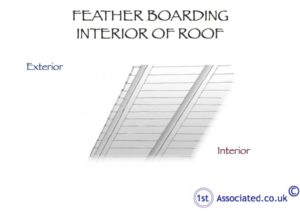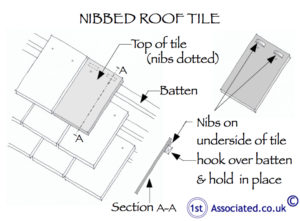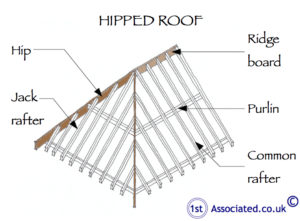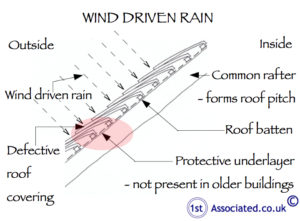Problems with Close Boarding
when used In Roofs
Technical Article
 If you need help and advice with regard to structural surveys, building surveys, engineers reports, defects reports, including things such as cracks, dampness, condensation, foundation problems, etc, home buyers reports.
If you need help and advice with regard to structural surveys, building surveys, engineers reports, defects reports, including things such as cracks, dampness, condensation, foundation problems, etc, home buyers reports.
Please free phone 0800 298 5424 for a chat with a surveyor.
INTRODUCTION
 From the early 1900's till about 1960 Close Boarding was used within roofs. This is where boards of a similar size to floorboards were placed next to each other to board the roof structure and were known as Close Boarding. Usually these boards were feather edged which means they are thicker at one end than the other, the thicker end being at the top. This thicker end leaves a ridge for the tiles to be hooked onto. The tiles used were predominantly nibbed clay tiles, nibbed so the clay hooking onto the top edge of the close boarding. We are going to look generally at close boarding that we find in a lot of older style properties. We will consider why close boarding was used and its benefits and also in our experience the problems that can arise which we have seen when carrying out surveys of properties.
From the early 1900's till about 1960 Close Boarding was used within roofs. This is where boards of a similar size to floorboards were placed next to each other to board the roof structure and were known as Close Boarding. Usually these boards were feather edged which means they are thicker at one end than the other, the thicker end being at the top. This thicker end leaves a ridge for the tiles to be hooked onto. The tiles used were predominantly nibbed clay tiles, nibbed so the clay hooking onto the top edge of the close boarding. We are going to look generally at close boarding that we find in a lot of older style properties. We will consider why close boarding was used and its benefits and also in our experience the problems that can arise which we have seen when carrying out surveys of properties.
SYNOPSIS
 We typically find Close Boarding in 1930's to 1950's properties and also properties that have hipped roofs. We need to look at how roof construction was in context to this. Prior to the use of Close Boarding we had used a cut timber frame, purpose made for the roof. Typically we would have a brick or stone gable end or timber frame and mottle and daub that would give strength and stability to the roof. However with the use of hipped roofs there is less stability in roofs. A way of adding strength was to Close Board the roof, albeit that it also used a lot of timber, it certainly did make a very strong roof. Hipped roofs have now been in place for over fifty years and deterioration and problems are starting to occur. A problem for property owners is the difficulty to see these problems, this is where a Surveyor carrying out a building survey of the property is very useful in identifying the risks as to re-roof a property is very expensive particularly today where scaffolding will be required. Often a roof is used over the top of the property formed in the scaffolding to stop any deterioration from any rain which as anyone experienced to British weather knows can come with next to no warning.
We typically find Close Boarding in 1930's to 1950's properties and also properties that have hipped roofs. We need to look at how roof construction was in context to this. Prior to the use of Close Boarding we had used a cut timber frame, purpose made for the roof. Typically we would have a brick or stone gable end or timber frame and mottle and daub that would give strength and stability to the roof. However with the use of hipped roofs there is less stability in roofs. A way of adding strength was to Close Board the roof, albeit that it also used a lot of timber, it certainly did make a very strong roof. Hipped roofs have now been in place for over fifty years and deterioration and problems are starting to occur. A problem for property owners is the difficulty to see these problems, this is where a Surveyor carrying out a building survey of the property is very useful in identifying the risks as to re-roof a property is very expensive particularly today where scaffolding will be required. Often a roof is used over the top of the property formed in the scaffolding to stop any deterioration from any rain which as anyone experienced to British weather knows can come with next to no warning.
We are going to look specifically at the problems and issues we have found with a close boarded roof in the London Hampstead area. We are also going to speak more widely about experiences we have had and close boarded roofs more generally and also going to advise you of research if any which has been in this area, ie. Learned Institutes or Bodies such as Building Research Establishment, TRADA (Timber Research and Development Association), we may even look at Wikipedia but we will not take it as gospel!
CONSTRUCTION SUMMARY

Typical stars of this type of property would be detached properties with red brick work at lower level and rendered sections at higher level with hipped roofs. The important factor being the hipped roof. Whilst the Close Boarding gives great stability to hipped roofs (as well as using lots of timber - we often say there is more timber in a Close Boarded house than in many modern developments of half a dozen houses. We don't know the facts behind this but we are sure we wouldn't be far off!)
This is the type of house that you would expect to have Close Boarding, what does it look like?
You need to gain access to the roof and look between the common rafters, the common rafters are the ones that form the pitch of the roof. In between them you will see Close Boarding. This looks very much like Shiplap Boarding you sometimes see on the outside of properties or horizontally clad timber panels or timber floorboards. Once you have identified these have a good look around to see what the average condition is. You are looking for areas which look to have deterioration from dampness, this can be seen from the change in colour or the way Surveyors will often find out is to use a electric protimeter. Surveyors should also look for specks of clay dust, these will be coming from the nibs of the clay tiles which indicate that the tiles are sitting on damp timber and the tiles are spalling.
Spalling Defined
Spalling occurs to brick or stone when water penetrates the surface and via freezing and thawing starts to cause deterioration to the surface. This in turn allows further water penetration and the surface breaks up further. This ultimately can lead to water damage or structural damage to the area.
Roofing Tile
Whilst we are talking about Close Boarding we also need to talk a bit more about the roofing tile. Typically these type of roofs will have originally been clad with a small clay tile which is nibbed, the nibs being to hold the tile in place. The nibs also being the only thing that holds the tiles in place. Therefore it is essential that they don't deteriorate. If they do this is another sign that there are problems with the roof. So if you look for roofs where there is a mixture of different coloured tiles, this is a good way of identifying the issue.
We always recommend that owners of any properties with older roofing tiles apply these for the windy days when a tile is displaced. With Britain seeming to have more extremes of weather, there is always a chance of this.
EXECUTIVE SUMMARY
Executive summaries are always dangerous as they try and encapsulate relatively complex problems in a few precise and succinct words. Having said that here is our executive summary and recommendations:
For those short of time, just like we have in our building surveys we have an Executive Summary here which identifies the main issues with a brief explanation.
Free phone 0800 298 5424
Close Boarding what is it?
It is a general term used where timbers are butted up next to each other. For your information the close boarding is horizontal . In this particular instance we are using it in reference to close boarding of a roof, although it also used to be the method we used for floorboards. Close boarding that is used on roofs is for several reasons:-
To give the roof added strength as it is often used on hipped roofs that are fundamentally stable and prone to move.
Close boards are shamord thereby giving a lip for the nibs on the clay tiles to hook onto.
Defects we have seen while surveying properties
Lots of loose tiles, replaced tiles this occurs where the nib of the clay tile has started to spall or deteriorate and literally disintegrates into a powder. Internally we can see damp or dark areas to the timber particularly where they butt against each other.
Problems that can occur with close boarding

In our experience the problems of rot that do occur have never been severe enough for us to recommend that a roof is completely replaced. Indeed one roof that we looked at where the Local Authority had put it down for replacement over a large block of flats was in our opinion repairable, certainly far better than the proposal to remove the close boarding and replace it with a sarking felt!
The biggest problems surrounding close boarding is the deterioration of the nib to the clay tile, which we believe occurs due to prolonged wind driven rain getting underneath the tile causing dampness in the close boarding.
Time Line A brief history of close boarding
1700's
Thatch used but the risk of fire became more and more apparent so new methods were sought.
1800's onwards
Blinding was used on the back of tiles. This is a lime mortar mix used to stick the tiles in place.
1900's
With the development of the transport systems both the canal and train systems, slates were used much more predominantly around the country which were nail fixed although you do have local varieties such as the pantiles of East Anglia and the stone tiles of Lincolnshire and Yorkshire.
1930's to 1950's
Close Boarding used on hipped roofs.
War Years
The introduction of a protective underlayer.
2000
The introduction of a breathable protective underlayer.
INSPECTION
We have carried out two different types of inspection on close boarding.
Visual
Damp meter
A visual inspection would consist of both an external view of the property looking at the tiles and the internal view of the Close Boarding. Then check internally with a damp meter to establish the condition of the timber.
SURVEY FINDINGS
The sort of things we have found when looking at close boarding is:
White staining to the rear of the board at the junction. The whiteness normally relates to salts but not certain where the salts come from in this instance?
The darker rotting of the timbers where rot has well and truly set in.
SUMMARY UPON REFLECTION
A Summary Upon Reflection is something that we include in all our reports and is where we review what we have discussed and here for example we would give a few extra thoughts on Close Boarding.
If you do carry out an inspection yourself do remember that close boarding is usually used on hip roofs and you have to check for movement in the structure as a whole, as roof spread pushes the walls out. You also need to look at other p roblems that could occur in the timber such as woodworm and also the potential it has for the wet rot to convert or change to dry rot.
We hope this information is helpful to you. If you would like specific help on your property please do not hesitate to contact us. Our details are in the information below.
Independent Surveyors
If you truly do want an independent expert opinion from a surveyor with regard to valuations, mortgages, mortgage companies, surveys, building surveys, structural reports/engineers reports, specific defects report, structural surveys, home buyers reports or any other property matters please contact 0800 298 5424 for a surveyor to give you a call back.
Commercial Property
If you have a commercial property, whether it is freehold or leasehold then sooner or later you may get involved with dilapidation claims. You may wish to look at our Dilapidations Website at www.DilapsHelp.com and for Disputes go to our Disputes Help site www.DisputesHelp.com
We hope you found the article of use and if you have any experiences that you feel should be added to this article that would benefit others, or you feel that some of the information that we have put is wrong then please do not hesitate to contact us (we are only human).
The contents of the website are for general information only and are not intended to be relied upon for specific or general decisions. Appropriate independent professional advice should be paid for before making such a decision.
All rights are reserved the contents of the website are not to be reproduced or transmitted in any form in whole or part without the express written permission of www.1stAssociated.co.uk
